Not every worthy comics story makes it to market. The celebrated Mr. K takes you behind the scenes of 13 Unsold or Unpublished Comics Stories and Proposals…
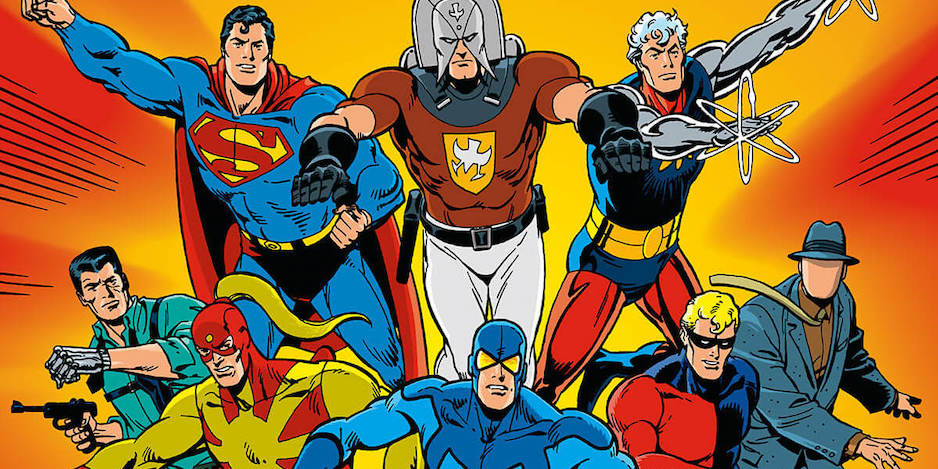
—
UPDATED 1/4/24: Diggin’ in the vault time — when we go deep into the recesses of the shadowy subterranean 13th Dimension headquarters for great columns that deserve another look. Just for kicks! This one first ran in January 2021. Right on! — Dan
—
By PAUL KUPPERBERG
Every writer has at least a few of them: unsold or unpublished proposals and stories, stashed in a file folder, either physical or virtual. I’ve had my share of them during my career. Some, I’ve been able to publish in recent years, including a jungle adventure Cat Girl story drawn by the late Pat Boyette for an issue of Archie Comics’ Blue Ribbon Comics that saw print in Charlton Neo Comics’ Lost Jungle Tales #1 in 2019, and the 2020 release of my Justice Society of America novel (now available in paperback and eBook on Amazon!) JSA: Ragnarok.
One of them, a 1980s Doom Patrol fill-in script penciled by Rick Stasi, was even eventually published by DC Comics, as bonus material in 2019’s Bronze Age Doom Patrol Omnibus. But most languish in those aforementioned folders, or maybe make it so far as my website, PaulKupperberg.com.
Here are 13 scripts and pitches from my flop file. Well, maybe “flop” is unfair; the five stories that were scripted and/or fully or partially drawn were left unpublished because the titles they were destined for were killed before they could be published. Some were solicited by an editor; others were undertaken by my own initiative. One eventually became a series but under a different title and with an altered concept. Most of the others were character specific and I never found comic book projects in which I could reuse the stories, although I was able to recycle one into a YA novel.
Here, in alphabetical order, are 13 UNSOLD OR UNPUBLISHED STORIES AND PROPOSALS:
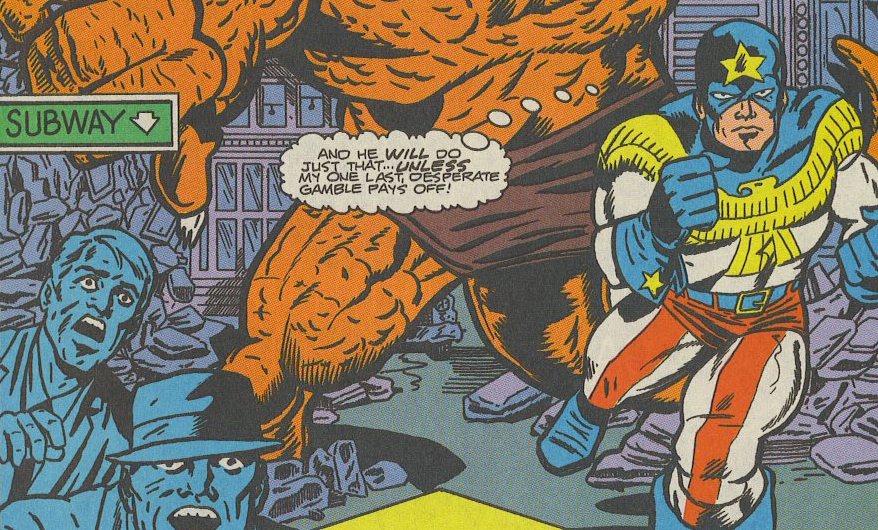
—
1. Black Canary and the Children’s Crusade, DC. “Dinah Lance is pregnant,” begins this 1989 proposal for a three-issue Prestige Format miniseries by me and, according to the name on the proposal, artist Michael Davis. “The Children’s Crusade” grew out of a conflict between Oliver Queen and Dinah from Mike Grell’s 1987 Green Arrow: The Longbow Hunters — the question of whether or not she wanted to bring children into the world in which they lived.
In the 1980s continuity, Dinah was the daughter of the original Black Canary and had grown up in the dangerous world of superheroes, surrounded by her super-powered “aunts” and “uncles” in the Justice Society. Besides, “these days it’s impossible to turn around without hearing reports of abused children, of the epidemic of drugs in the streets and schools, of the poor quality of education, of gang violence, of dangerous influences assaulting them from the media, of hazardous chemicals in the air, water, and food. In short, it seems that everything conspires against a kid being able to grow up whole and unaffected by the dangerous influences surrounding them.”
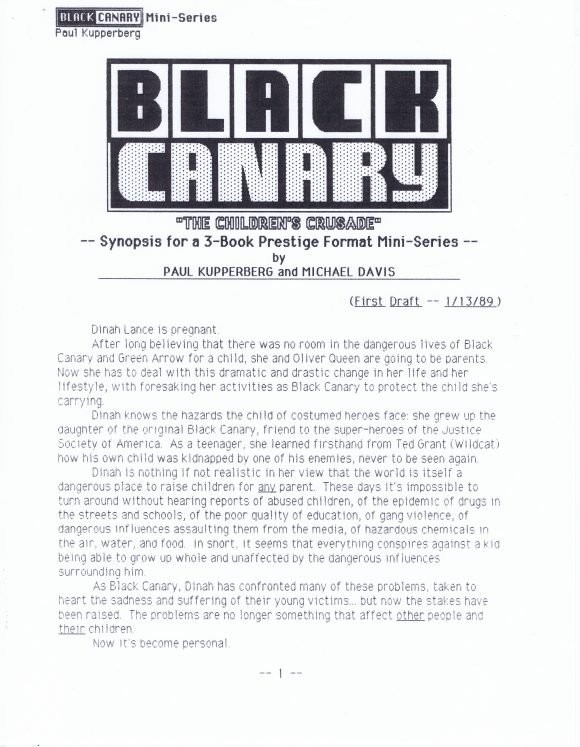
Stir into that mix a spotlight on several kids in a variety of hazardous situations and a ruthless drug dealer and I’m pretty sure I could have wrung enough drama, anger, and angst for a trio of square-bound books. Frankly, I don’t remember a lot about the project; it seems like something that would have been suggested to me by an editor, maybe with Michael already attached to it?
What happened: Like many proposals, this one disappeared down the submissions black hole and was never heard from again.
—
2. Black Thorn Series Proposal, DC. I introduced Black Thorn as a female counterpart and love interest for Adrian Chase, the lead psycho in Vigilante #45 (Sept. 1987). By then, I think we knew the end was near so we had a good character who was close to and could react to Adrian’s rapid decline. (Spoiler alert: Horrified by what he’d become after gunning down his second police officer in #50, Vigilante took his own life at the end of that final issue.)
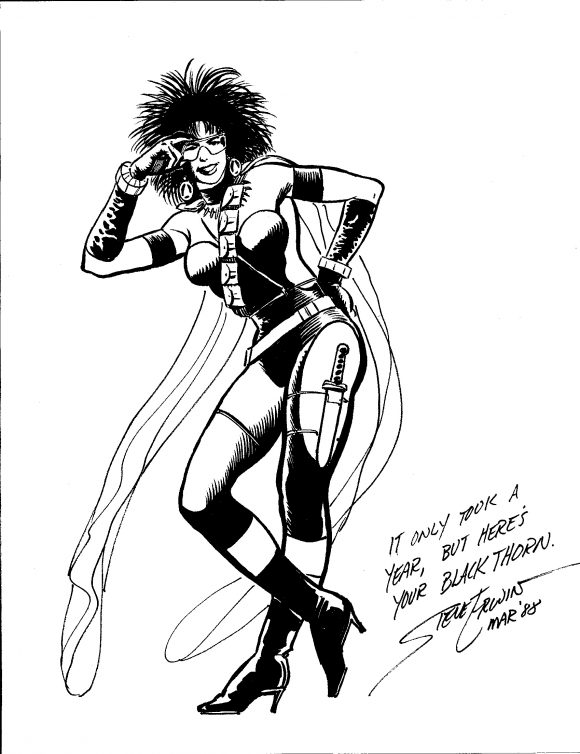
Black Thorn made the jump with several other supporting characters to Checkmate, but she refused to work for the agency and be under the government’s control and rules, so I thought I would try to spin her off into her own ongoing series. Working off the few clues I had dropped about her background in Vigilante and Checkmate, I expanded on Elizabeth Thorn’s history and origin: Bored rich girl joins the CIA for the excitement, fakes her own death so she can become a vigilante… you know, the usual.
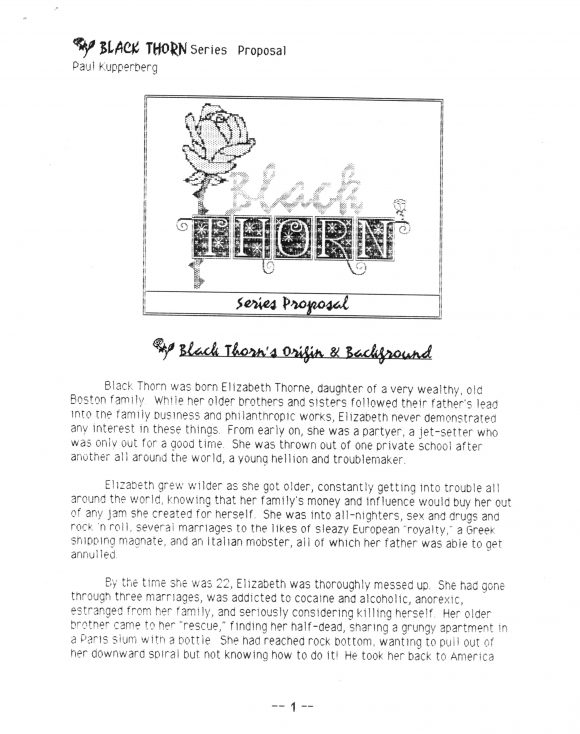
I added a supporting cast, a mix of Checkmate holdovers, DC retreads (Tim Trench, the private eye from the 1960s Wonder Woman/I Ching era), and newbies, assigned her a few bad guys (mostly new, but including the Electrocutioner from Vigilante), whipped up a year’s worth of possible story ideas, and cast it into the water.
What happened: Nobody took the bait.
—
3. Blood of the Andrews Clan, Archie. From 2010 to 2014, I wrote Life With Archie, the “what if?” series that asked the timeline-divergent questions, “What if Archie married Betty?” and “What if Archie married Veronica?” I think you know the answer by now: He wound up dead in both realities.
Having accepted the idea of multiple realities and having a hit with “The Death of Archie,” the company dove into the horror genre with Afterlife With Archie and Sabrina. Turning Jughead into a werewolf was pretty radical stuff, but it showed just how dark they were willing to go. “Blood of the Andrews Clan” was my humble attempt to match the darkness.
The premise was the blood curse that had been put on the Andrews and Lodges almost a century earlier. Learning that he owns the long-abandoned Riverdale Asylum for the Criminally Insane, Mr. Lodge visits the old property and emerges a changed (i.e., possessed) man, and his visit unleashes a horde of nightmares and horrors on Riverdale, including Archie’s nightmares about an ancestor who was a doctor at the Asylum. As blood curses will, this one heats up and brings the two families to war and the brink of destruction.
What happened: The proposal was left somewhere to just bleed out of neglect.
—
4. Captain Atom, DC. DC acquiring the rights to the Charlton Comics “Action Heroes” in the early 1980s is a well-told tale, as is the story of how Alan Moore had planned to star them in his Watchmen project. But before Moore put his claim in on the Charlton heroes, DC had planned in 1985 for Comics Cavalcade (or possibly Blockbuster) Weekly, a title that would have carried the weekly serialized adventures of Captain Atom, the Blue Beetle, Thunderbolt, Peacemaker, the Question, Judomaster and Sarge Steel.

Colors by Scott Dutton
DC was well into the book before the plug was pulled on the project. Scripts and even finished art exist for some of the features, including a Dave Gibbons cover, Peacemaker pages by Keith Giffen, and my plots and scripts for 12 episodes of a Captain Atom serial, written after I replaced original writer/artist Paul Chadwick on the strip. The first four parts are six pages long; the rest of them run four pages each and the story introduces us to NASA Mission Control Specialist Captain Nathaniel Adam, aka Captain Atom, and his supporting cast and the menace of the Atomic Skull.
I believe Dick Giordano was overseeing Comics Cavalcade Weekly, but Bob Greenberger was my editor on the Captain Atom strip. These being full scripts, I also typed in the credits; the first 11 list Rick Hoberg as the penciller, but that changed to Jose Delbo in the last script and it was Jose who drew the completed but never published first installment. Editor Greenberger has no memory of Jose on the strip, recalling instead that Denys Cowan had been assigned to pencil it.
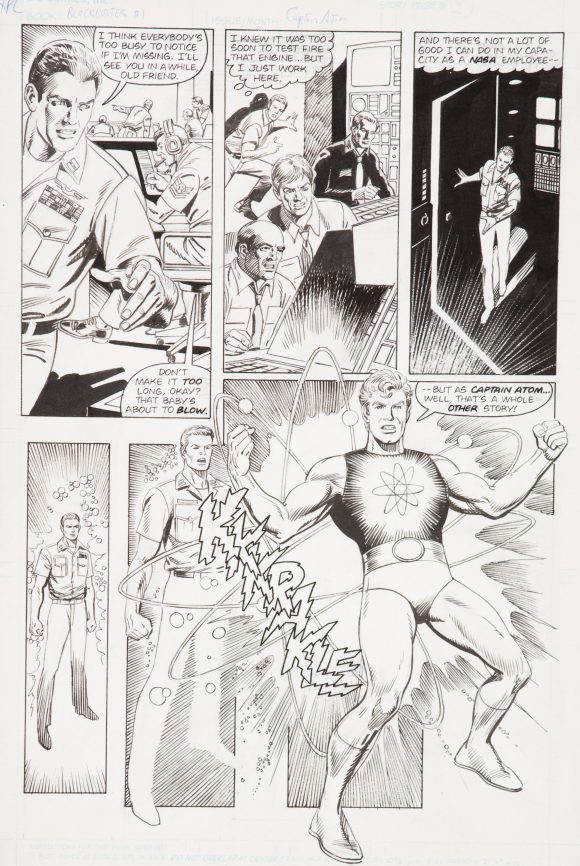
Jose Delbo
What happened: Comics Cavalcade Weekly imploded.
—
5. DC Double Comics: Superboy, DC. So, here was the plan in early 1984: Supergirl would end with #23 and New Adventures of Superboy would stop with #54, then the two strips would be revamped and relaunched in a new shared title, DC Double Comics (DCDC). Julie Schwartz would still be the editor and I would remain the writer, but Carmine Infantino (now paired with inker Klaus Janson) would take over the art on Superboy.
Sounded awesome! Other than the fact that I’d already scripted NAOS #55, which wrapped up a major storyline, I was excited to take these two characters in new directions. For the Teen of Steel, I would introduce the Galaxians, a new team of teen superheroes from across time and space to help him ward off a menace that threatens the entire universe.
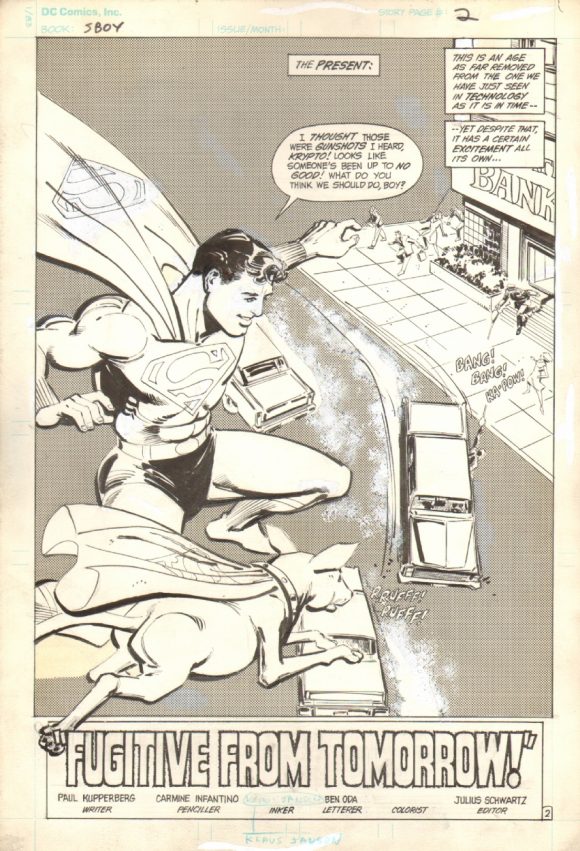
I wrote the scripts for the first two issues (they’d share the rotating 24-page lead slot and 16-page back-up slots), Carmine penciled the first stories, Ben Oda lettered it… Klaus Janson inked at least the splash page of the Superboy story… and we got word to stop work.
What happened: Crisis on Infinite Earths was coming to town and, oh, by the way, neither of my lead characters would still exist when it was all over.
—
6. DC Double Comics: Supergirl, DC. Meanwhile, Supergirl’s new artist was Eduardo Barreto, who turned in a stunning first chapter for the pilot issue of DCDC; Bob Oksner was slated to ink, but I don’t believe any of the pages ever went to him before the plug was pulled; Ed King was the letterer. A pity. I would have loved to see how Oksner handled Eduardo’s beautiful pencils.
Feeling she had fallen into a rut, I sent the Maid of Might away from Earth to spend some time on New Krypton with her parents — and without her superpowers — before she was to go off adventuring in space to find herself.
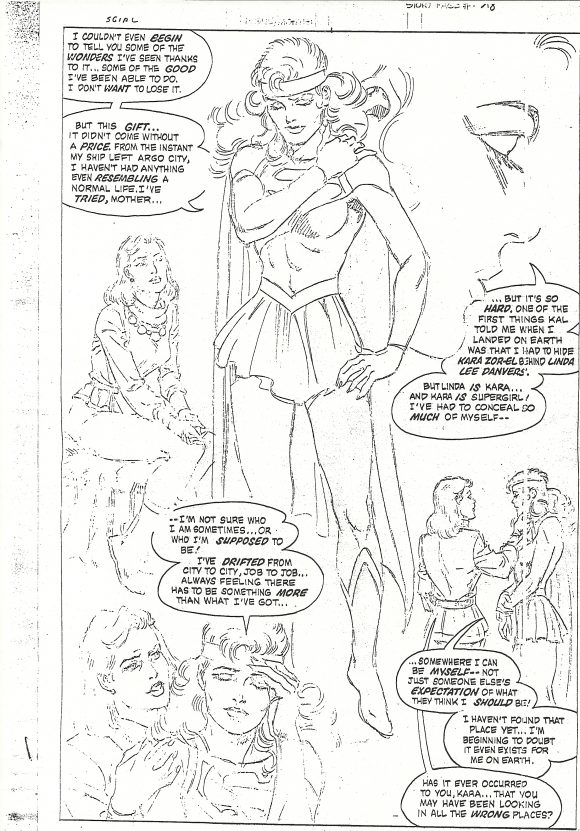
After 30 or so years of people asking me, “What did you have planned for DC Double Comics?” I finally put out the finished scripts for New Adventures of Superboy #55 and DC Double Comics #1 and #2 (with an introduction by comics historian John Wells) in book form. If you’re one of the curious, The Unpublished Comic Book Scripts of Paul Kupperberg is still available on Amazon.com.
What happened: See above.
—
7. General Glory, DC. General Glory was an inside joke character from the Keith Giffen/J.M. DeMatteis Justice League America (#46, Jan. 1991), a supposed “real” World War II hero whose existence was partially hidden by a mask of fiction as a comic-book character.
General Glory was played as an over-the-top, tongue-in-cheek patriot, kind of Captain America but with an even tighter sphincter. I wrote a handful of 10-page General Glory back-up features for Justice League Quarterly, each of them in the style of different comic book eras, working off the premise that the General was a long-running comic book feature.
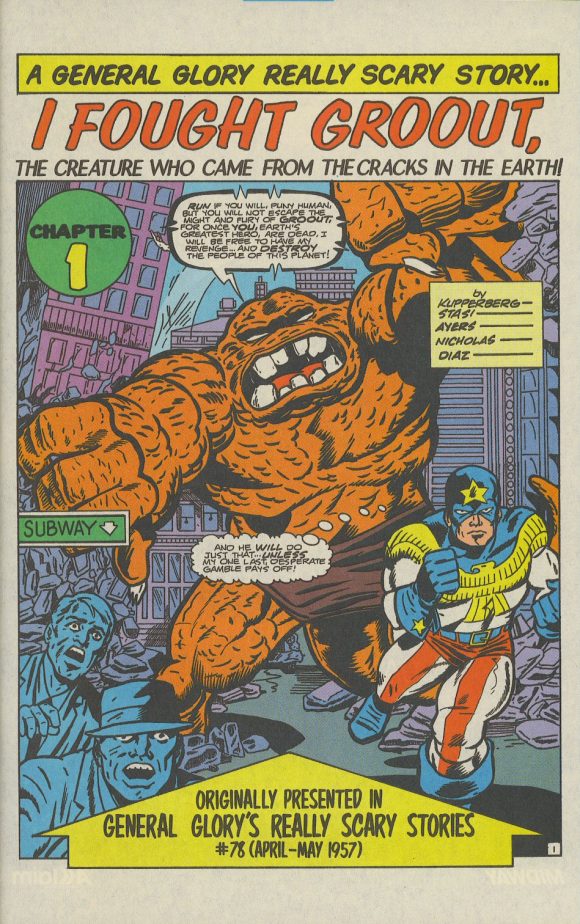
For instance, one written in the style of a 1950s Lee & Kirby Marvel monster story was called “I Fought Groout, the Creature Who Came from the Cracks in the Earth” and featured art by Rick Stasi and, for verisimilitude, was inked by actual 1950s Jack Kirby and Marvel monster story inker, Dick Ayers. A take-off of a 1950s-style Superman story, “‘Moolah’ Murphy Goes Straight!” was penciled by 1950s Superman penciller Curt Swan.
A batch of those stories were published in Justice League Quarterly #16’s (Sept. 1994) “All Glory Issue” as flashbacks by an old, dying Joe Jones, telling the tales to his hospital roommate, paralyzed cop Jack Wallace, to whom he will eventually pass on the powers of General Glory before he himself passes on. My subsequent series proposal would have taken the new Glory out into the world to discover for himself the meaning of patriotism and heroism.
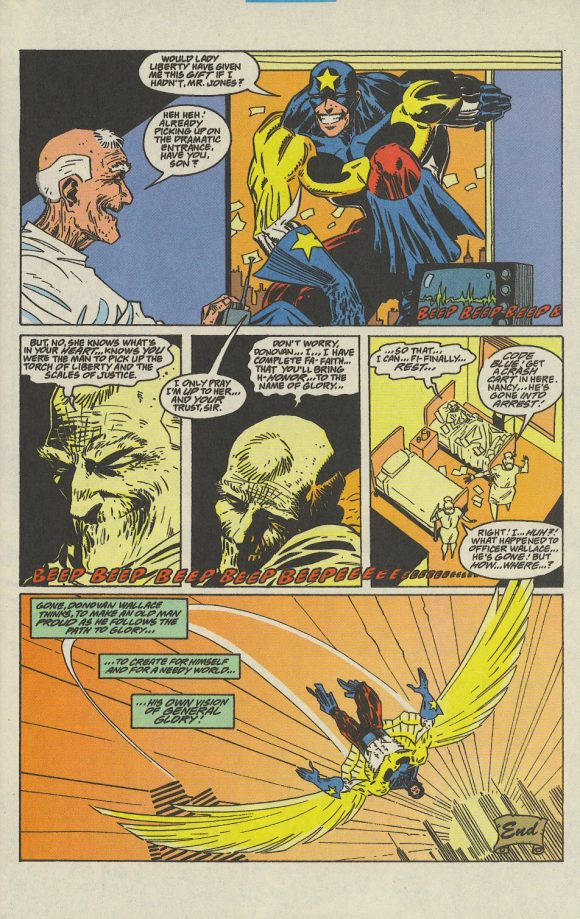
Vince Giarrano
What happened: No Glory.
—
8. Justice League of America: American Dream, DC. Would Joss Whedon or Zack Snyder have been able to survive in the Elseworlds realm of the Justice League’s “American Dream”? This proposal is from the early 1990s and the only response I remember getting was, “There’s a lot of history in it, isn’t there?”
The premise: Rather than the 20th century being a time of social and economic reform more in favor of the working class, it was dominated by the economic interests of the corporations and the likes of the Rockefellers, Edisons, Waynes, and Fords. By the latter half of the century, the world is run by the corporations and the working class is kept in line with guaranteed employment and creature comforts. (That’s where “a lot of history” came in; in fact, it would have taken maybe a page out of the 64.)
So, who needs superheroes in a docile, contented world? The corporations use them for entertainment; Justice League of America is a popular science fiction TV show about a group of heroes who fight evil in a darker reality, plus they make great spokespeople for companies and products. But when a menace greater than anything the world has ever faced before emerges, the pretend TV heroes have to find it in themselves to become true heroes.
What happened: DC Comics didn’t share my dream.
—
9. Legends of the DC Universe: Green Lantern, DC. In my professional career, I’ve almost never played the “I hate that bit of continuity, I have to fix it!” game. Why bother? Whatever I “fix” is likely to get broken again by another writer down the road, maybe in a way that I’ll hate even more. But when the opportunity came along to at least put a band-aid on the bit of continuity I hated from Green Lantern #48-50 (Jan.–March 1991) “Emerald Twilight,” I jumped at the opportunity.
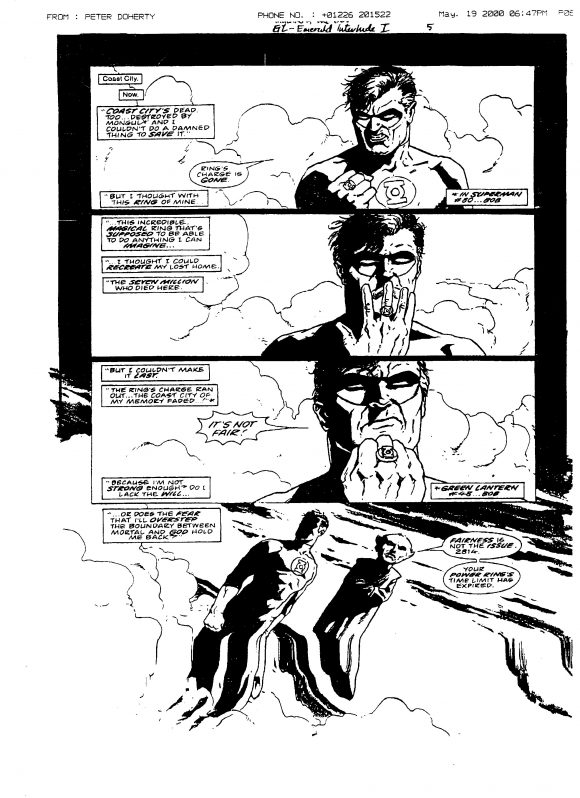
What I hated: Hal Jordan going from the noblest motherf’er in the universe to the proto-Parallax who kills a Guardian to consume his Battery energy and then wipes out the rest of the GL Corps in the space of a few panels. Even “Emerald Twilight” writer Ron Marz thought the change rather abrupt and told me, for a 2013 Back Issue article, “The initial ‘Emerald Twilight’ storyline was given to me in an editorial outline of just a couple pages… Ideally, I would’ve preferred about six issues to tell the story. Hal’s descent into… well, if not madness, at least psychosis… is abrupt, especially after he was portrayed as relatively normal in issue #47.”
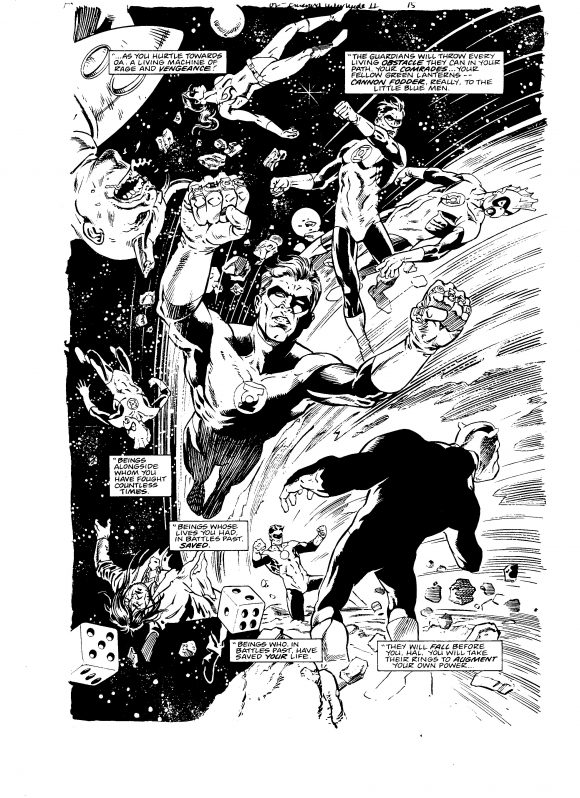
What I did: I came up with “Emerald Interlude,” a story that took place literally between the panels of “Emerald Twilight,” when Hal is grabbed by Hunter of the Linear Men in the instant before he zaps the Guardian. They proceed to time-jump up and down Hal’s lifeline until Hal learns that it had been Sinestro who’d been responsible for the jet fighter test-flight crash that killed his father, so consuming Hal with rage that he throws away everything to get his revenge on Sinestro. It was convoluted, made all the more so by the editor’s insistence this two-parter be done over three issues.
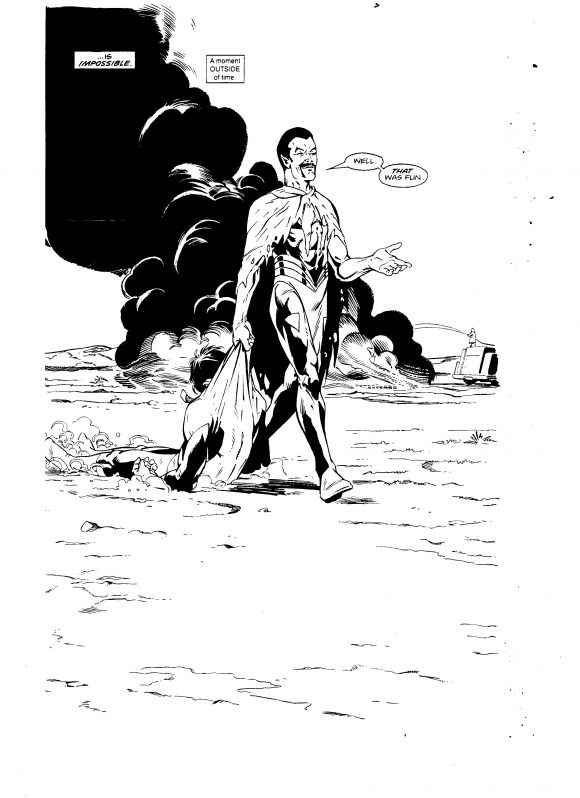
What happened: Legends of the DC Universe, the book “Emerald Interlude” had been commissioned for, was cancelled before the story ran, but not before all three issues were penciled by Peter Doherty, inked by Joe Rubinstein, and lettered.
—
10. The Trickster, DC. “You know who’s funny?” an editor asked me, circa 1990. “No,” I responded, “who’s funny?” “The Trickster!” he said. “The Trickster? You mean the Flash villain, with the pointy flying shoes?” He nodded eagerly. I shrugged; sure, the Trickster was funny! Everything was funny if you looked at it the right way. Then he says, “You want to work up something to do with Stephen DeStefano?” Well, that got my attention.
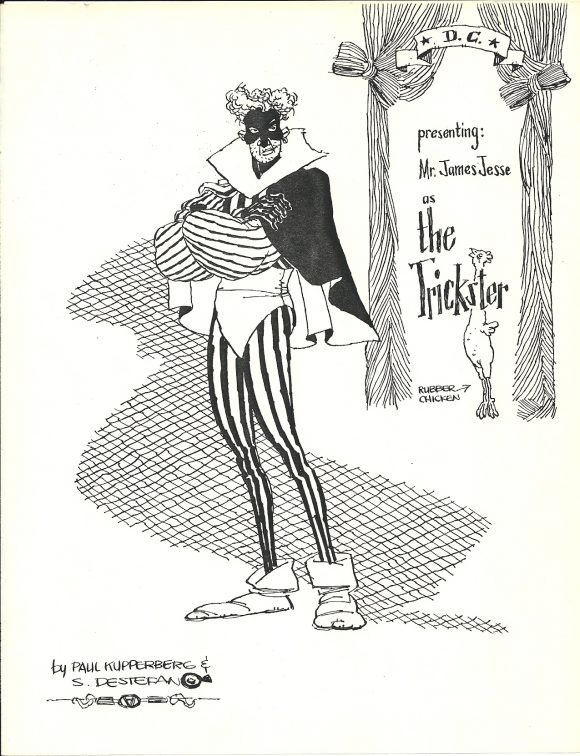
I took apart the Trickster and put him back together, funny bits facing out. James Jesse, aka Trickster, knew that he wore funny pointed shoes and a silly costume. He knew that he was always getting his ass kicked and thrown into prison and finally decides to break the pattern by giving up his life of crime and moving out of the city and away from the temptation to commit them.
Hilarity ensues when he moves to the tiny town on the Jersey shore where he’s inherited a house from his late aunt to start his life anew. The town is relatively isolated due to a variety of reasons and is home to a variety of odd and eccentric people, all of whom were beautifully designed by Stephen.
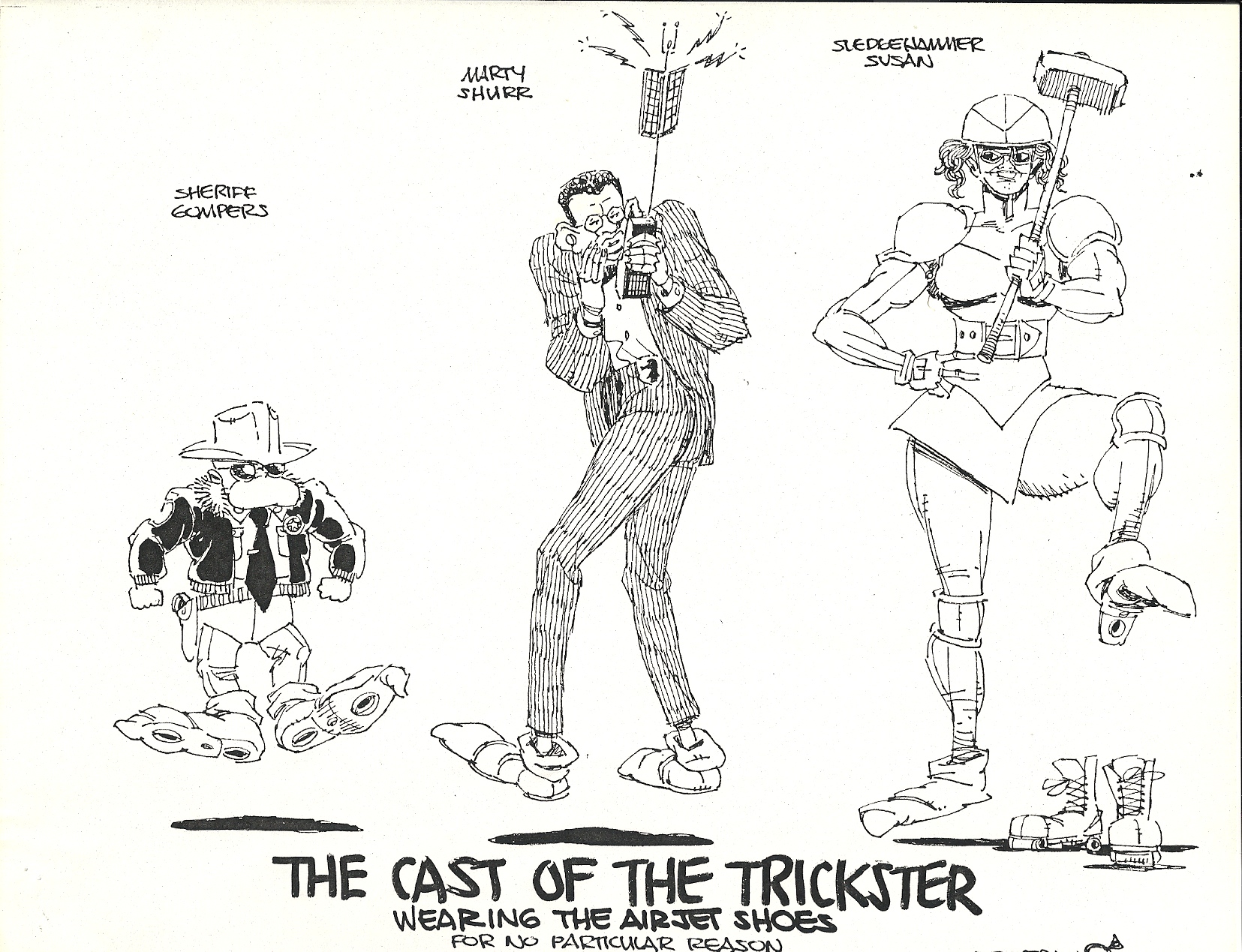
What happened: Endless nitpicky rewrite requests from the editor before the proposal disappeared into the void. But I did repurpose the idea into the YA novel Supertown, soon to be published by Endpapers Press.
—
11. The Saga of Starman, DC. I had been the editor on the latest incarnation of Starman, the 1988 Roger Stern/Tom Lyle version who died fighting Eclipso in 1992’s “The Darkness Within” crossover event. I’ll confess to not having much feeling for that version of the character; I was only following orders, shepherding the title to its already determined final issues.
A couple of years later, while talking to an editor about projects we might work on together, he suggested I take a stab at Starman. Revivals/revamps of known characters/names stood a better chance of being approved than something totally unknown, and I could rebuild the idea from the ground up, keeping only the names.
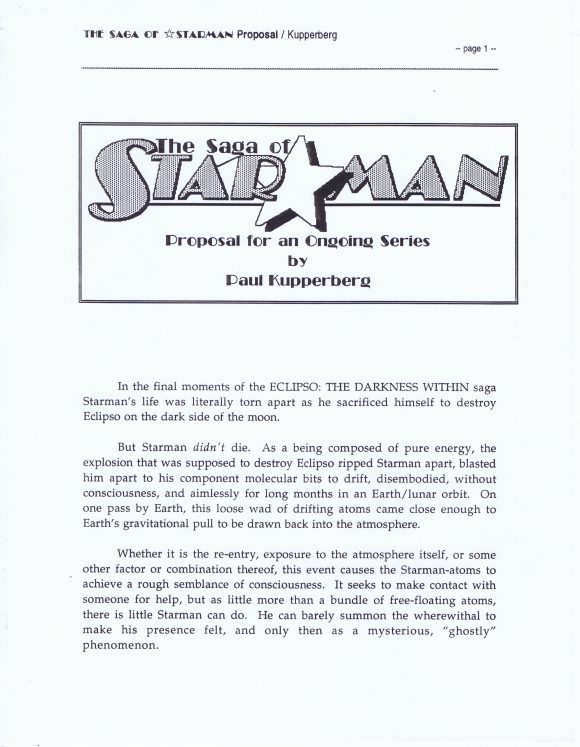
Which I did, breaking Will Payton down to his constituent molecules and making him one with the cosmos before bringing him back as, essentially, a new character (again; this was, what, the third or fourth incarnation?). Which I did, and, after a bit of tinkering, settled on something that both the editor and I were happy with, and submitted it to the powers that be… only to have it bounced back with the information that James Robinson and Tony Harris were already working on a new character with that name.
What happened: We changed the character’s name to Takion, rewrote the backstory and tied it in to Kirby’s Fourth World in order to anchor the series in the DCU, and sold it. Drawn by Aaron Lopresti, Takion lasted seven whole issues in 1996. Oh well.
—
12. The Riverdale Chronicles, Archie. I liked this idea so much I wrote the entire 24-page script for the first issue on spec and coerced artist Jason Armstrong to make some sketches. The idea was simple: While cleaning out the attic, Archie finds the Andrews Family Journal, dating back to the first Andrews to settle Riverdale in the 1750s. In it, he finds a fascinating family history, as well as some family mysteries. The first story arc is set in the opening days of the Revolutionary War and finds Archie and the gang (or the ancestors thereof) playing their roles in American, and Riverdale, history.
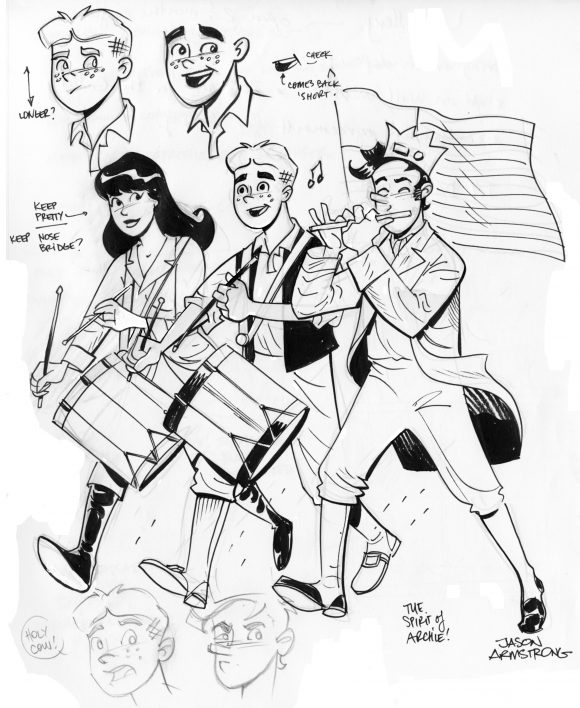
I was still writing Life With Archie in 2011 when I pitched this idea to my editor, the late Victor Gorelick. He loved the idea (enough to see that I got paid for my spec script) but never closed the deal; I think at the time when this sort of thing was still new to them, they felt one ongoing series was enough for Archie to bear. And, by the time they were comfortable with the concept, they’d already moved beyond the semi-serious tone rendered in the cartoon style and were on to the horror phase of their evolution.
What happened: Riverdale Chronicles was consigned to the dustbin of history.
—
13. Pop Tate, Archie. Here’s what we know about “Pop” Tate: His name is Terry, he owns the Chocklit Shoppe in Archie’s Riverdale, and according to Jughead, makes the best hamburger in the world. In 2017, when contemplating a series of one-shots starring various supporting cast members, I was asked to come up with a story for Pop Tate.
The proposal for the 40-page one-shot takes us back to before Terry became Pop, when he was being called Junior because his father was then known as “Pop” and still owned the Chocklit Shoppe. Much to his displeasure, Terry got stuck behind the counter while his siblings got to go off and have their own lives and he grew to hate the Chocklit Shoppe, turning to the bottle to drown his unhappiness.
But the thing he hates most becomes his salvation when he learns after his father’s death and he inherits the Shoppe, just how much the place, and the Tates, mean to the people of Riverdale. He finds himself honored to be crowned by them as the new “Pop” Tate.
What happened: We didn’t make it onto the menu.
—
Paul Kupperberg has been writing comic books from Archie to Zatanna for 45 years at DC, Archie, Charlton, Marvel, Bongo and others. He is also the author of Paul Kupperberg’s Illustrated Guide to Writing Comics (Charlton Neo Press); I Never Write for the Money… But I Always Turn in the Manuscript for a Check (Comics Career); the comic book industry-based murder mystery The Same Old Story, the short-story collection In My Shorts: Hitler’s Bellhop and Other Stories, and JSA: Ragnarok (all from Crazy 8 Press), all of which are currently — or shortly will be — available at Amazon.
—
MORE
— PAUL KUPPERBERG: My 13 Favorite Comic Book Stories I’ve Written. Click here.
— PAUL KUPPERBERG: My 13 Favorite Short-Lived Series of the 1960s. Click here.

January 19, 2021
Congratulations on getting that JSA novel out, Mr. Kupperberg. I was lined up to write the second book in that trilogy-that-never-happened when Byron Preiss passed and the licensing deal with DC fell through, so I’ll have to order a copy now to see how yours turned out!
January 19, 2021
What a really breathtaking article this is! 😀
January 21, 2021
The unpublished content discussed in this article cries out for a new edition of Cancelled Comics Cavalcade.
January 22, 2021
Weren’t you also involved in a proposed Space Ranger mini? I always imagined the unused plot got recycled into a Star Trek issue.
January 23, 2021
I was editor for a SPACE RANGER proposal by Michael Jan Friedman and John Calimee that didn’t get picked up.
January 4, 2024
https://www.progressiveruin.com/
January 4, 2024
Any of us who have submitted to DC have these kind of stories. I personally submitted multiple stories to DC that vanished and then they appeared with other writers’ names on them. Batgirl getting her legs back, Superman’s origin based on the GL’s blowing up Krypton because they couldn’t allow billions of Kryptonians to reach a yellow sun, The Bruce Wayne Murder Trial (based on OJ). It is all about who you know…THAT’S how you get work at DC.
January 4, 2024
Klaus Jansen inking Carmine Infantino is a surprisingly good combo!
January 4, 2024
I’m so glad things worked out that Moore never got his hands on the Charlton heroes. I would have hated to see Blue Beetle and the others put through that dark lens.
January 4, 2024
That Riverdale Chronicles idea is very similar to an actual Archie cartoon series that used to air in my area on sunday mornings…. 1974’s “U.S. of Archie”. They told historical true stories and events, with the Archie characters playing the parts…. I seem to remember a LOT of revolutionary war stories.
January 4, 2024
My favorite MIA comic book was what was originally to have debuted in Showcase #60: The Spectre & Dr. Mid-Nite. Only The Spectre made the Final Cut. If someone would photoshop a cover, I’d love to write “Spectre and Dr. Mid-Nite” in the 1960’s style of Gardner Fox.
January 4, 2024
Love this inside glimpse into what might have been! I know I’ve heard the Pop Tate background story before (maybe in that Archie Encyclopedia that came out a while back!) And I agree with you about Eduardo’s beautiful pencils!
January 5, 2024
If the three issues of “Emerald Interlude” were penciled by Peter Doherty, inked by Joe Rubinstein, and lettered, could they be a candidate for a future run of “fauxsimile” issues?
January 5, 2024
“Peacemaker pages by Keith Giffen…”
That would explain how Keith Giffen got the art assignment on the Peacemaker entry in the first volume of DC’s WHO’S WHO.
January 7, 2024
Man those ideas would’ve been good to read. I am wondering if for Emerald Twilight’s anniversary if you could convince them to finally publish Emerald Interlude.
January 7, 2024
I’m struck by how many of these DC ideas have come to pass – in one way or another.
• Black Canary is currently fighting for her adopted daughter’s life in the pages of the new Birds of Prey series.
• Captain Atom wound up having his own series in the late 80s that ran for 57 issues.
• Superboy (the clone, Kone-El/Connor) wound up joining the short-lived group the Ravers in the 90s – a group of superhero teenagers from around the universe.
• During the Bendis era of the Superman books, Supergirl went off into space (with Krypto) to find herself and her place in the universe.
• That premise for the Justice League Elseworlds sounds a little too close to the current reality. Let’s face it – corporations DO run the world right now. They just don’t guarantee employment OR creature comforts (they don’t even guarantee the means for basic survival!)
• Hal’s sudden turn to evil in Emerald Twilight was retconned in Geoff John’s run on the character to explain how it happened so quickly.
• During Underworld Unleashed, Mark Waid took Trickster and tuned him into a self-aware character who knows he’s always being kicked around and is determined to make a change (though instead of moving to the Jersey shore, he out-smarts a demon).
• Pretty much what you proposed with Will Payton is what happened to him in James Robinson’s run of the character. His body reforms in space and it is revealed that he is actually the reincarnation of another Starman – Prince Gavyn of Throneworld.
About the only one I can’t find a correlation to is General Glory. Since Justice League Quarterly, I think he has only been seen in the background of a few group shots during one inevitable Crisis or another, but only until New 52.
Also, the Riverdale Chronicles sounds awesome.
March 29, 2025
Another sin against Crisis on Infinite Earths! I’d have loved to have seen the Superboy and Supergirl stories! Superboy’s series was quite engaging at the time. What a shame. COIE also effectively killed one of my all-time favorite DC series, All-Star Squadron, and also didn’t do my favorite DC series, Legion of Super-Heroes, any favors.